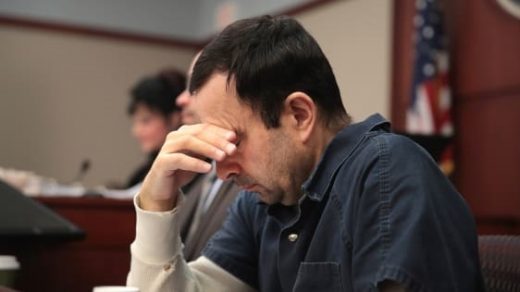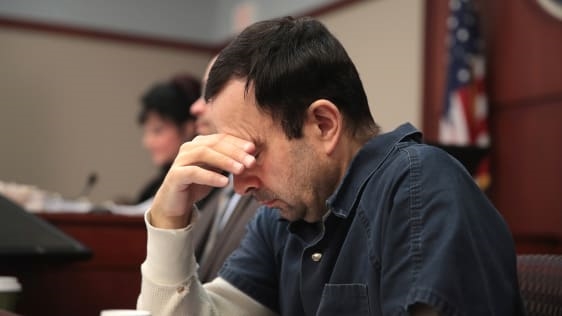How the IndyStar Broke The USA Gymnastics Abuse Scandal
(January 31, 2018) former Olympic doctor Larry Nassar was sentenced to 40 to 175 years in prison for sexually assaulting hundreds of girls over the course of decades. That was the culmination of a seven-day hearing that riveted the world with heart-wrenching stories from his victims. None of this would have been possible were it not for a crack team of reporters and editors who first learned about Nassar’s crimes.
It all began about two years ago, when a group of three journalists from the Indianapolis Star–Marisa Kwiatkowski, Mark Alesia, and Tim Evans–began looking into Indiana school systems that failed to report sexual abuse by officials. According to Kwiatkowski, while interviewing sources, one person told the reporter she should also look into USA gymnastics.
Being a good and diligent reporter, she decided to follow that lead. So Kwiatkowski and her colleagues began combing through legal records, trying to find women who had experienced abuse while operating in the gymnastic circuit. Thus began their blockbuster series about USA Gymnastics turning a blind eye to sexual assault, which focused predominately on coaches.
The First Woman
When the first story in the series went live, it caught the eye of a former gymnast named Rachael Denhollander. She contacted Alesia on August 4th, 2016, the day the article went live, and told the journalist that she too had a story about sexual assault. “It wasn’t by a coach,” recounts Alesia, “it was by a doctor.” Alesia followed up and shortly thereafter traveled to Louisville, KY to talk to Denhollander in person. “What we found was pretty much what the world saw (January 31, 2018) in court,” says Alesia.
“She was very poised, very smart, serious women,” he says of his first interview with her. “She had medical records there for us to see. She had done her own research.”
She was an ideal source for these kinds of stories, even though it took her years to tell her story. Denhollander hadn’t come forward earlier because she thought she’d never be believed. She kept her story hidden because of the power Nassar yielded.
Then she read the IndyStar‘s stories about the coaches and everything changed. “She came forward at that time because she liked the way we dealt with the survivors in the first story,” says Alesia. “She’s a lawyer–she liked the way we had conducted everything. I think we earned her trust before we met.” He adds, “that was my speculation.”
Getting Victims To Talk
Getting victims to talk is very difficult, for obvious reasons. These are all people whose trust had been broken in an irrevocable way; getting women who were taken advantage of and assaulted as minors to open up and become even more vulnerable is a truly Herculean task.
According to Kwiatkowski, they were able to break the initial gymnastics story by being calm and forthright in their approach. “We were very up front with what we were working on and why we wanted to talk with them,” she says, “giving them an opportunity to ask questions as well.” Ultimately, the stories worked because they got many women to open up, and the seasoned journalists did this by making sure every source was comfortable. They checked every detail with every source before they went public. And most importantly, the team was very specific about what they were describing.
“We were very explicit in our language to make sure the public understood what was going on,” says Kwiatkowski.
Through this meticulous reporting, they were able to build the story. After listening to Denhollander, they were able to find a few more survivors with similar stories. From there, they knew they had something on Nasser. The doctor had a pristine record; “we were really going up against a high bar,” says Tim Evans.
But the IndyStar went forward with the story–after it first published, hundreds of women came forward with their own stories about Nassar. The story’s editor, Steve Berta, says there was one very specific thing that prompted the onslaught of victims to speak out. Before the first Nassar story went live, Evans drove to Michigan to talk with the doctor and hear his side of things. During their time together, Nassar’s attorney denied that Nassar had ever conducted the assaulting procedures the women described. The flat-out denial was included in the story.
“When women saw that–women who he had done just that to–they were outraged,” says Berta. “It was that legalistic denial that really stuck with and angered the victims.”
A Real Impact
With that, dozens of people came forward with their own story. The team realized, recounts Berta, “holy cow, this is big.” The story also got a boost from the USA Today network, which ran the article in newspapers across the country. “That gave us a reach we wouldn’t have normally had,” says Evans. “It helped us get the word out.
For the trio of IndyStar journalists, this week’s verdict crystalizes to them the importance of investigative journalism. Though they’ve won numerous awards over the last year, it’s people’s reactions and real change that are most important.
For Alesia, it was a truly bright spot in his career when the prosecutor, in her closing argument, “basically gave a shoutout to investigative journalism.”
He goes on, “I think all of us feel a little beaten up lately with the fake news stuff.” But the prosecutor wanted to make sure people, both in the courtroom and around the world, understood the impact of journalism. “I just found that really heartening, and I’m grateful for that.”
Fast Company , Read Full Story
(30)














